 |
 |
 |
 |
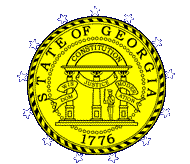













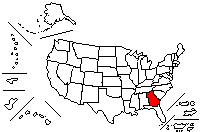
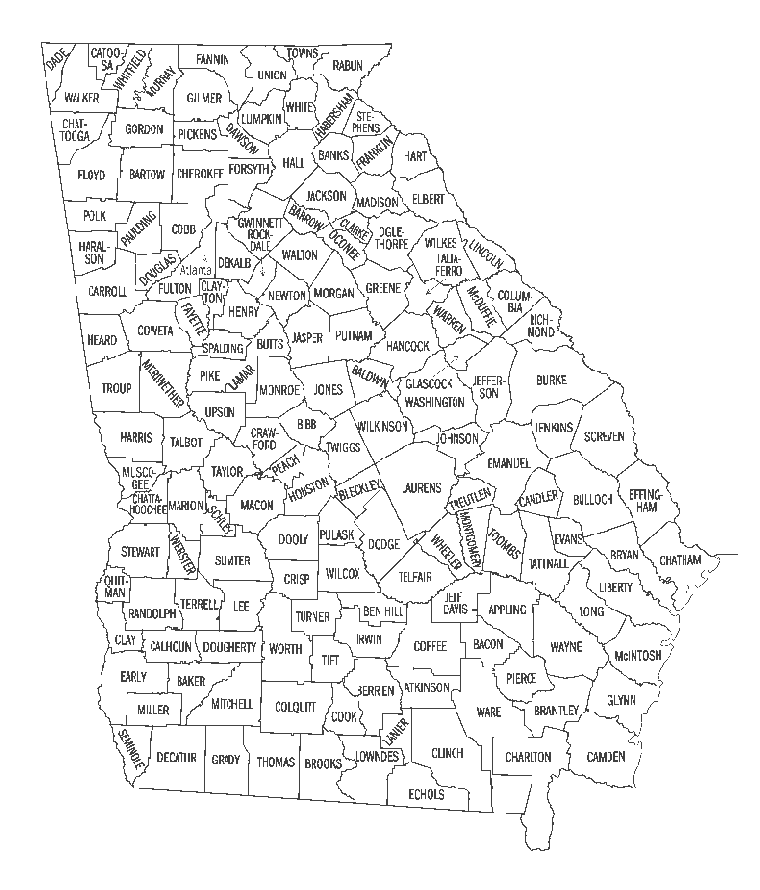

Georgia on My Mind | Georgia en mi Mente Georgia, Georgia, |

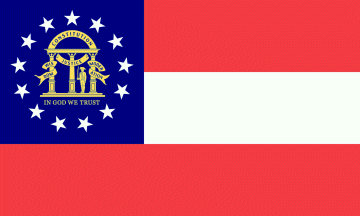
Bandera
" la bandera del estado de Georgia consistirá en un cantón cuadrado
en un campo de tres franjas horizontales de igual anchura. Las dos franjas
de los extremos serán escarlata y la del centro en blanco.
La franja inferior ampliará la longitud entera de la bandera,
mientras que las otras dos franjas se extenderán del
cantón al extremo de la bandera. El cantón de la
bandera consistirá en un cuadrado del azul la anchura de dos de las
franjas, al extremo donde va el asta. En el
centro del cantón será colocado una representación en oro del escudo de
armas de Georgia según aparece en el centro del
del gran sello del estado de Georgia adoptado en 1799 y
enmendado en 1914. Centrado inmediatamente debajo del escudo de armas
sea las palabras ' EN DIOS CONFIAMOS ' en mayúsculas.
EL escudo de armas y de la fraseología será roedeado por 13 estrellas
de 5 puntas,
representando Georgia y los 12 estados originales que formaron los Estados
Unidos de América. Las especificaciones oficiales de la
bandera, incluyendo sistema de la identificación de color, los
tamaños y las fuentes de tipo, y las dimensiones totales, serán
establecidas por la secretaria del estado, a que conforme a la
sección del código 50-3-4 sirve como guardián de la bandera del
estado."
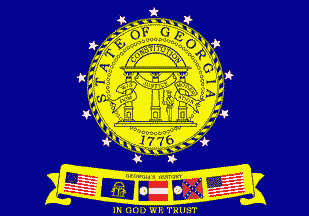
On January 31, 2001 Governor Roy Barnes signed into law a bill to change the design of the state flag. For more than 15 years, opponents of the flag rallied and introduced legislation aimed at removing the confederate emblem featured prominently on the 1956 state flag. Because of the controversy, many Georgia cities and private businesses throughout the state refused to fly the official Georgia flag, opting instead to display the pre-1956 version.
In early 2000, Atlanta architect Cecil Alexander brought forth a "compromise" flag design consisting of the state seal, fittingly depicted in "Dahlonega Gold," surrounded by 13 white stars. Below is a gold ribbon containing small images of the three state flags that have flown over Georgia, as well as the current and past versions of the United States flag. Above the small rows of flags is the phrase "Georgia's History."
On January 24, 2001, the Georgia House approved H.B. 16, adopting Alexander's flag design as the new state flag with an amendment to add "In God We Trust" beneath the ribbon of flags. H.B. 16 was then transmitted to the Senate, where it was passed without amendment on January 30, 2001.
Bandera
En el campo azul de la bandera de Georgia presenta el sello del estado, en una cinta expresa la historia de la bandera de Georgia y las palabras "En Dios Confiamos". Trece estrellas rodean el sello prepresentando la posición de Georgia como una de las trece colonias originales. En el sello hay tres pilares que apoyan una arco que representa las tres ramas del gobierno; legislativo, judicial y ejecutivo. Un hombre con una espada representa la defensa de la Constitución, cuyos principios son la sabiduría, justicia y moderación. La fecha 1776 es la fecha cuando se firmó la Declaración de Independencia. Una cinta presenta la bandera de los Estados Unidos con trece estrellas (1777-1795), la primera bandera de Georgia (1879), la segunda bandera de Georgia (1920-1956), la tercera bandera de Georgia (1956 - 2001) y la bandera de los Estados Unidos con cincuenta estrellas. Esta bandera fué adoptada el 30 de enero de 2001.
El 31 de enero de 2001 el gobernador Roy Barnes firmó una ley para cambiar el diseño de la bandera del estado. Por más de 15 años, los opositores de la bandera reunieron e introdujeron la legislación dirigida a quitar el emblema confederado que aparecía prominentemente en la bandera 1956 del estado. Debido a la controversia, muchas ciudades de Georgia y negocios privados a través del estado rechazaron enarvolar la bandera oficial de Georgia, optando en lugar de otro exhibir la versión de 1956. < P > Al principio del 2000, un arquitecto de Atlanta, Cecil Alexander trajo consigo el diseño de la bandera que consistía del sello del estado, apropiadamente representado en el color oro de Dahlonega, rodeado por 13 estrellas blancas. Debajo está a la cinta del oro que contiene las imágenes pequeñas de las tres banderas del estado que han enarvolada en Georgia anteriormente, al igual que la actual y anterior versión de la bandera de los Estados Unidos. Sobre las filas pequeñas de banderas está la frase "Historia de Georgia."
En enero 24 de 2001, la Legislatura de Georgia aprobaron H.B. 16, adoptando el diseño de la bandera de Alexander como la bandera nueva del estado con una enmienda donde agruegarona "en Dios confiamos" debajo de la cinta de banderas. 16 H.B. entonces fué llevada al senado, donde fué aprovado sin enmienda el 30 de enero de 2001.
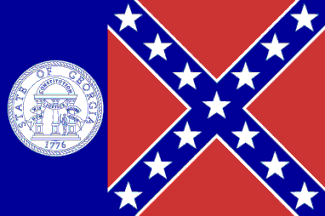
In early 1955, Atlanta attorney John Sammons Bell (who later served as a judge on the Georgia Court of Appeals) suggested a new state flag for Georgia that would incorporate the Confederate Battle Flag. At the 1956 session of the General Assembly, state senators Jefferson Lee Davis and Willis Harden introduced Senate Bill 98 to change the state flag. Signed into law on February 13, 1956, the bill became effective the following July 1.
A copy of the new flag displayed at the 1956 signing ceremony shows slight differences from the state flag currently in use (and shown above). In the 1956 version, the stars are larger and only the center point of the central star points straight up. Also, the first copies of the 1956 flag used a different version of the state seal. In the summer of 1954, a new redrawn state seal began to appear on state government documents. By the end of the decade, flag makers were using the new seal on Georgia's official state flags.
A principios de 1955, el abogado Jonh Sammons Bell (quién de Atlanta sirvió más adelante como juez en el tribunal de apelación de Georgia) sugirió una nueva bandera para el estado de Georgia que incorporaría la bandera confederada de la batalla. En la sesión 1956 de la Asamblea General, los senadores del estado Jefferson Lee Davis Willis Harden introdujeron el proyecto de ley 98 del senado para cambiar la bandera del estado. Firmado en ley de febrero el 13 de 1956, la ley llegó a ser eficaz el julio siguiente 1.
Una copia de la bandera nueva exhibida en la ceremonia 1956 de la firma muestran pocas diferencias de la bandera del estado anterior. En la versión 1956, las estrellas son más grandes que el de la bandera confederada. También, las primeras copias de la bandera 1956 utilizaron una diversa versión del sello del estado. En el verano de 1954, un nuevo sello del estado comenzó a aparecer en documentos del gobierno del estado. Para el final de la década, los fabricantes de la bandera utilizaban el nuevo sello en las banderas oficiales del estado de Georgia.

Georgia
Capital City: Atlanta
Admission to Statehood: January 2, 1788
National: Georgians
Motto: Agriculture and commerce, 1776 and Wisdom, Justice, Moderation
These mottoes appear on the great seal of the state—one on the obverse, the other on the reverse. Agriculture and commerce, of course, describe the mainstay of Georgia’s economic well-being. Wisdom, justice, and moderation refer to the virtues that should guide legislative, judicial, and executive branches of government.
Nickname: Peach State
Origin of state's name: Named for King George II of England
State Pledge: "I pledge allegiance to the Georgia flag and to the principles for which it stands: Wisdom, Justice, and Moderation."
Georgia (se pronuncia Yór-llia en inglés y español)
Ciudad Capital: Atlanta (se pronuncia At-láan-ta en inglés)(At-lán-ta en español)
Admición como Estado: 2 de enero de 1788
Gentilicio: Georgianos (yorllanos)
Lema: Agricultura y comercio, 1776 y Sabiduría, Justicia, Moderación.
Estos lemas aparecen en el sello del estado, uno al frente y otro al reverso. Agricultura y comercio describe el soporte económico de Georgia. Sabiduría, justicia y moderación se refiere a las virtudes que deben guiar a las ramas legislative, judicial y ejecutiva del gobierno.
Cognómento: Estado color durazno.
Origen del nombre: nombrado en honor a George II rey de Inglaterra.
Promesa a la bandera: Prometo lealtad a la bandera de Georgia y a los principios que representa: Sabiduría, Justicia y Moderación.


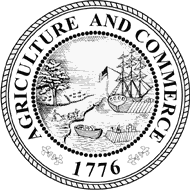
State Seal
The current Great Seal of Georgia was adopted by the State Constitution of 1798. On its front side appear three pillars supporting an arch, emblematic of the three branches of government - the legislative, judicial and executive. A man stands with a drawn sword defending the Constitution whose principles are wisdom, justice and moderation. The reverse of the Seal reads "Agriculture and Commerce 1776" and shows a ship with cotton and tobacco, and a man plowing. In 1914, the date on the Seal was changed from 1799 to 1776 to correspond with the date of the Declaration of Independence. By law, the Secretary of State is the official custodian of the Great Seal, which is attached to official papers by executive order of the Governor. Except for the date it bears, the present Great Seal has been in use since 1799 with the exception of the period 1863-1865, when a specially designed Great Seal was used, and the period 1868-1871, when it was hidden by Secretary of State Nathan C. Barnett. In 1872, it was restored by Mr. Barnett after Georgians were again in power in the state. During the Three Governors' Controversy in 1947, Secretary of State Ben W. Fortson, Jr. hid the Great Seal under the cushion of his wheelchair until the Georgia Supreme Court decided who was the rightful Chief Executive.
Sello Estatal
Es sello de Georgia fué adoptado por la Constitución estatal en 1798. En la parte frontal del sello aparese tres pilares apoyando un arco, que representan las tres ramas del gobierno - la legislativa, la judicial y la ejecutiva. Un hombre de pie con una espada defendiendo la Constitución cuyos principios son la sabiduría, justicia y moderación. En el reverso se puede leer "Agricultura y Comercio 1776" y presenta una embarcación con algodón y tabaco y un hombre arando. En 1914 la fecha del sello fué cambiada de 1799 a 1776 para que correspondiera con la fecha de la Declaración de Independencia. Por ley, el secretario de estado is el custodio oficial del Gran Sello, el cual es utilizado en los documentos oficiales por orden ejecutiva del Gobernador. Exceptuando por el cambio de fecha en el Sello, el Sello actual ha sido utilizado desde 1799 con exepción al período de 1863-1865, cuando un Sello especialmente diseñado fué utilizado, y el período 1868-1871 cuando fué ocultado por el Secretario de Estado Nathan C. Barnett. En 1872 el mismo fué restaurado por Mr. Barnett despues que los georgianos protestaron en el estado. Durante la Controversia de Tres Gobernadores en 1947, el Secretario de Estado Ben W. Fortson, Jr. escondió el Gran Sello bajo el cojín de su sillas de ruedas hasta el la Corte Suprema de Georgia decidió quien era el legitimo Gobernador.

HISTORY
Georgia is the largest state east of the Mississippi River. Its territory extends from the Sea Islands on the Atlantic shore to the forested mountains of the southern Appalachians. Georgia shares borders with five states, bounded on the east by South Carolina and the Atlantic Ocean, on the west by Alabama, on the north by Tennessee and North Carolina, and on the south by Florida.
The earliest known inhabitants of present-day Georgia are thought to have been Mound Builders, predecessors of the Cherokee and Creek Indians inhabiting the area at the time of European arrival. Mound Builders, in archaeology, is a general term used to refer to the peoples who constructed earthen mounds and other earthworks in eastern and central North America during prehistoric times.
Hernando de Soto crossed Georgia in 1539-40, vainly searching for precious metals and gems, but he established no settlements on the mainland. Mound Builders, in archaeology, is a general term used to refer to the peoples who constructed earthen mounds and other earthworks in eastern and central North America during prehistoric times. Savannah, the first European settlement in Georgia, was established in 1733 by James Oglethorpe--a British general and member of parliament--for economic and philanthropic reasons. King George II of England granted a charter to Oglethorpe in order to provide a new home for the poor of England, as well as an outpost against attacks from Spanish Florida. In 1752 the trustees turned over control of the colony to the royal government. Georgia became actively involved in the American Revolution in 1778 when the British captured Savannah. This seizure was followed by the eventual British seizure of all Georgia except for Wilkes County. Settlement had first expanded along the coastal zone and Sea Islands. Interior settlement occurred later, between 1770 and 1840, when settlers moved southwestward from Virginia and the Carolinas. That it took nearly seven decades after 1770 to complete the settling process of the state was in no small part due to the resistance of the Creek and Cherokee Indians. In a series of land cessions, the Creeks were pushed westward from river to river, until by 1826 all Creek Indian lands had been seized. During the following 12 years the Cherokee Indians of north Georgia--an Indian nation remarkably advanced and rapidly acculturating--were also deprived of their territory. In 1838 the federal government forcibly removed the Cherokee people to lands in western territory, an exodus that would come to be known as the "trail of tears." Portions of Georgia, such as the Pine Barrens of southeast Georgia and the southwest, remained sparsely populated until well after the Civil War. Along the coast and on the Sea Islands a black culture known locally as "Gullah" developed among the slaves tending the cotton and rice fields.
The advance of settlement between 1780 and 1840 was encouraged by improved cotton-ginning technology and the increased markets for cotton in Europe. The corollary of this was an intense demand for land, for slaves, and for the removal of Indians. The expansion of the planter system not only set distinctive demographic patterns but established a social, economic, and political structure that prevailed in the state well into the 20th century. The Civil War was a period of disruption and destruction in Georgia. The Union army of General William Tecumseh Sherman crossed the state in 1864. After burning Atlanta in November of that year, he and his 60,000 men moved eastward, reaching Savannah in 29 days and leaving devastation in their wake. During Reconstruction the Georgia legislature's refusal to ratify the 14th Amendment placed the state under military rule. Georgia was readmitted to the Union in 1870. Although slavery was declared illegal, planters and former slaves adopted a tenancy system that kept many blacks and whites in poverty until the system's demise after World War II. In addition, few late 19th-century European immigrants coming to the United States settled in Georgia, leaving the prevailing social system undisturbed.
The U.S. history Reconstruction refers to the period (1865-77) following the Civil War and to the process by which the states of the Confederacy were readmitted to full membership in the Union. The period was marked by struggles between political parties about how Reconstruction should proceed and between the president and Congress over who should direct it.
Differing Views of Reconstruction
Reconstruction aroused violent controversy over the constitutional powers of the federal government to intervene in a state's affairs, over whether the victors should try to change the South fundamentally, and over the status of the black ex-slaves, or freedmen. Political affiliations were a key determinant of views on those issues. Northern Democrats believed the Constitution strictly limited federal power, anticipated that most Southern whites would vote Democratic, and had little sympathy for black aspirations. They favored a rapid Reconstruction that would make few demands on the ex-Confederates. Republicans took a broader view of federal power. The more radical of them believed that the secessionist states had forfeited their status and could be treated by Congress as territories or conquered provinces. Republicans also thought that steps had to be taken to forestall future rebellions. In addition, most felt that blacks were entitled to fundamental human rights, and many hoped Southern Republicanism could be built with the help of black support.
Historia
Georgia es el estado más grande al este del río de Mississippi. Su territorio extiende dedes Sea Island en la orilla atlántica hata las montañas de los Apalaches meridionales. Georgia comparte las fronteras con cinco estados, limitados en el este por Carolina del sur y el Océano Atlántico, en el oeste por Alabama, en el norte por Tennessee y Carolina del norte, y en el sur por la Florida.
Se cree que los primeros habitantes conocidos de Georgia actual para haber sido los constructores de montículos, precursores de los indios cherokee y del cala que habitan el área a la hora de llegada europea. Los constructores de montículos es un término general usado para referir a la gente que construyó los montones de tierra y otros terraplenes en Norteamérica del este y central durante épocas prehistóricas.
Hernando de Soto cruzó Georgia en 1539-40, vanamente buscando metales preciosos y gemas, pero él no fundó ningún establecimiento en el continente. La Sabana, el primer establecimiento europeo en Georgia, fue establecida en 1733 por James Oglethorpe -- un general y un miembro del parlamento británico -- por razones económicas y filantrópicas. Rey George II de Inglaterra concedió una carta a Oglethorpe para proporcionar un nuevo hogar para los pobres de Inglaterra, así como un puesto avanzado contra ataques de la Florida española. En 1752 los administradores se volvieron contra el control de la colonia del gobierno real. Georgia se implicó activamente en la revolución americana en 1778 cuando los británicos capturaron a La Sabana. Este ataque fué seguido por el ataque británico de toda la Georgia a excepción del condado de Wilkes. El poblado se había ampliado a lo largo de las islas costeras de la zona y del mar. El poblado interior ocurrió más adelante, entre 1770 y 1840, cuando los colonos movieron la tutela de sudoeste desde Virginia hasta las Carolinas. Que tomó casi siete décadas después de 1770 para terminar el proceso ya que no fué fácil debido la resistencia de los indios cherokee y Creek. En una serie de entrega de tierra, los Creek fueron empujados hacia el oeste del río en río, hasta que antes de 1826 todas las tierras de los indios Creek habían sido agarradas. Durante los 12 años siguientes privaron a los indios Cherokee de Georgia del norte -- una nación india avanzada notablemente -- también le privaron de su territorio. En 1838 el gobierno federal forsosamente removió a la gente cherokee de sus tierras en territorio occidental, ese éxodo que vendría ser conocido como el "camino de lágrimas." Las porciones de Georgia, tales como el Pine Barrens de Georgia suroriental y del sudoeste, seguían escasamente pobladas hasta mucho después de la guerra civil.
A lo largo de la costa y en las islas del mar una cultura negra conocida localmente como " Gullah " se convirtió entre los esclavos que tendían a los campos del algodón y de arroz. El avance del establecimiento entre 1780 y 1840 fue animado por tecnología mejorada del algodón y los mercados crecientes para el algodón en Europa. La consecuencia de esto era una demanda intensa para la tierra, para los esclavos, y para el retiro de indios. La extensión de los patrones demográficos no solamente establecido para el sistema de siembra sino estableció una estructura social, económica, y política que prevaleció en el estado bien en el vigésimo siglo. La guerra civil era un período de la interrupción y de la destrucción en Georgia. El ejército de la unión de general William Tecumseh Sherman cruzó el estado en 1864. Después de quemarse Atlanta en noviembre de ese año, él y sus 60.000 hombres se movieron hacia el este, alcanzando La Sabana en 29 días y dejaron una estela de devastación. Durante la reconstrucción la denegación de la legislatura de Georgia para ratificar la 14ta enmienda puso el estado bajo regla militar. Georgia fue readmitida a la unión en 1870. Aunque la esclavitud era declarado ilegal, los plantadores y los esclavos anteriores adoptaron un sistema del arrendamiento que mantuvo muchos negros y blancos en la pobreza hasta la eliminación del sistema después de la guerra mundial II. Además, los últimos inmigrantes europeos 19th-century que venían a los Estados Unidos y fueron a Georgia, dejaron el sistema social que prevalecía sin cambios.
La historia de la reconstrucción de los ESTADOS UNIDOS se refiere al período (1865-77) que sigue la guerra civil y al proceso por el cual los estados de la Confederación fueron readmitidos a la calidad de miembro en la unión. El período fue marcado por luchas entre los partidos políticos sobre cómo la reconstrucción debía proceder y entre el presidente y del congreso sobre quien debía dirigirla. Los diferentes puntos de vistas sobre la reconstrucción despertaron controversia violenta sobre los poderes constitucionales del gobierno federal de intervenir en los asuntos de un estado, sobre si los vencedores deben intentar cambiar el sur fundamentalmente, y los asuntos de los ex-esclavos negro, liberados. Las afiliaciones políticas eran un determinante dominante de opiniónes sobre esas ediciones. Los demócratas norteños creyeron el poder federal era limitada por la constitución, anticipando que la mayoría de los blancos meridionales votarían democrata, y tenían poca simpatía por las aspiraciones de los negros. Favorecieron una reconstrucción rápida que haría pocas demandas a los ex-confederados. Los republicanos tomaron una visión más amplia del poder federal. El más radical de ellos creyó que los estados secesionistas habían perdido derecho a estado y se podrían ser tratado por el congreso como territorios o provincias conquistadas. Los republicanos también pensaron que las medidas tuvieron que ser tomadas para prevenir las rebeliones futuras. Además, la mayoría se sentían que los negros se le debía dar derecho a los derechos humanos fundamentales, y muchos esperaban que la Georgia meridional se podría construir con la ayuda de ayuda negra.
